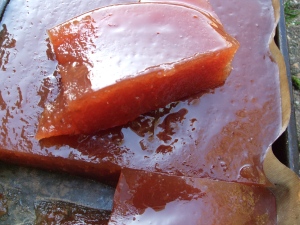The next in my series of homemade Christmas presents: quince paste (membrillo to the Spanish). It didn’t feature in my gift plans until I saw two gloriously enormous quinces outside the Moroccan deli. It was an impulse buy, but the sort that doesn’t leave you with buyer’s remorse. The owner was quite curious about what I would be doing with them (in Morocco, he said, they would stew it with lamb).
I’m afraid that, like the previous two recipes, this one is quite time consuming, but you don’t have to do much during that time other than be around. I plan to give it to people in slabs with a nice piece of cheese, some manchego or a Cashel blue maybe. The basic recipe I used comes from Stevie Parle (see also: other quince recipes) and he suggests putting it inside a roasting game bird or eating it on toast. I think it would also be nice instead of the jam layer in a bakewell tart, or in small pieces in an apple pie or crumble (I think I’ve stolen that last idea from somewhere).
Quince paste
Makes as much as you have quinces
Where I differed from Stevie’s recipe was to blend the mixture to make a smooth paste, for aesthetic neatness. You can skip this for a coarser paste.
Quinces (I used two large ones which weighed just over 1kg)
About the same amount of sugar as quince
Preheat the oven to 180c. Put the whole quinces in a deep roasting tin, add 2.5cm water and cover with foil. Bake for two hours, or until completely soft. Take them out and leave them until they’re cool enough to handle.
Pull the quinces apart and discard the hard core. Any soft bits, including the skin, can be kept, although you might want to get rid of any black bits that you don’t want in the paste. Weigh the soft flesh and the remaining liquid from the tray and put it in a saucepan – preferably with a heavy base – along with roughly the same amount of sugar (if you want to use a bit less, another recipe I consulted suggested three quarters sugar to quince pulp.) Put the pan on a low heat, stir and cook until the paste turns a deep red colour. If you want to blend it, you can do this when the sugar has dissolved using a hand-held blender. Stevie says this cooking process ‘might take an hour’ – it took me an hour and three quarters. It might seem like nothing is happening at first, but it will darken a lot and start to thicken considerably. You just need to stir it occasionally and check it’s not sticking on the bottom of the pan.
When it’s ready, pour it into a tray lined with baking parchment and leave it to set. Wrapped up pieces can be kept in an airtight box.
Adapted from Stevie Parle’s ‘Real Food From Near and Far’
